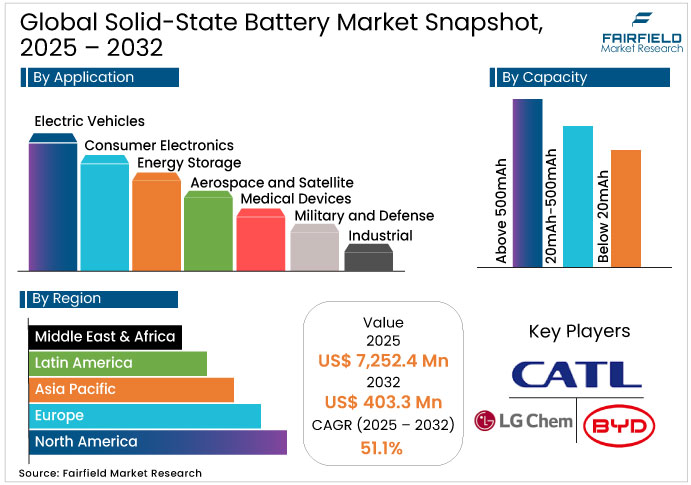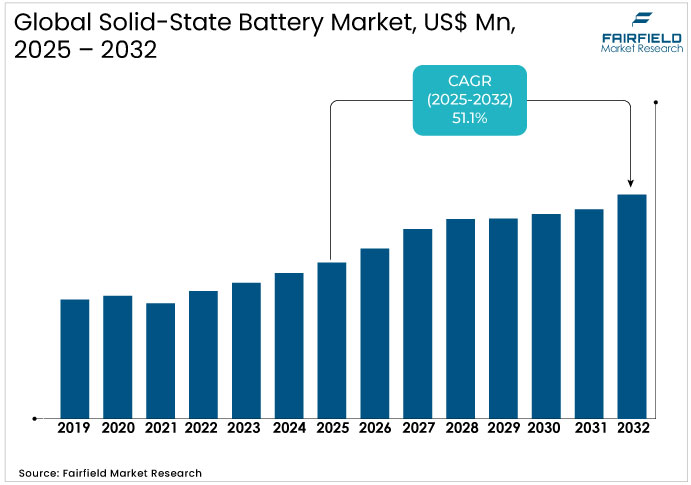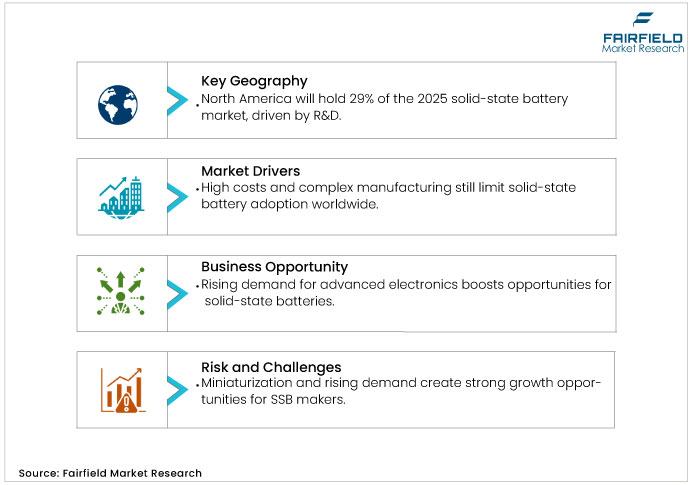Global Solid-State Battery Market Forecast
- The global solid-state battery market is expected to reach a market size of US$ 403.3 Mn by 2032 from its current size of US$ 7,252.4 Mn in 2025, indicating strong growth with a 51.1% CAGR during this period.
- Rising demand for high-energy-density, safe, and fast-charging battery solutions across diverse end-use industries, including electric vehicles (EVs), consumer electronics, medical devices, and renewable energy storage systems are key factor bolstering the global solid-state battery market.

Solid-State Battery Market Insights
- Growing demand for high-energy-density batteries in electric vehicles (EVs) driving the global SSB market.
- High production costs and a lack of scalable manufacturing infrastructure limit the widespread commercialization of solid-state batteries.
- Rising demand for next-generation consumer electronics presents a lucrative market for solid-state batteries.
- Strategic partnerships and joint ventures are driving solid-state battery commercialization.
- Bulk Battery gains prominence due to demand for high-energy storage applications.
- Electric vehicles emerge as the leading application driven by industry shift towards long-range and safer mobility.
- North America market is strengthened by strong R&D and strategic industry collaboration.
- Europe market is boosted by environmental regulations and decarbonization goal.
- Asia Pacific SSB market expanding rapidly due to EV adoption and electronics manufacturing hub.
Key Growth Determinants
- Growing demand for high-energy-density batteries in electric vehicles (EVs) driving the global SSB market
The global shift toward electric vehicles (EVs) as a sustainable transportation solution is a key driver of the solid-state battery (SSB) market. According to the International Energy Agency (IEA), the global electric vehicle (EV) stock surpassed 17 million units in 2024, reflecting a tripling since 2018. The growth trajectory continues, with projections estimating over 200 million EVs on the road by 2030 under current policy frameworks.
This surge in EV adoption highlights the urgent need for batteries with higher energy density, improved safety, and faster charging times, qualities that solid-state batteries inherently offer. Traditional lithium-ion (Li-ion) batteries, though dominant, face limitations such as flammability risks due to liquid electrolytes, constrained energy density, and performance degradation over multiple cycles. Solid-state batteries, featuring solid electrolytes, promise 2-3 times greater energy density, enhanced thermal stability, and a longer lifespan, effectively addressing critical challenges in EV performance.
Major automotive companies and battery manufacturers are heavily investing in solid-state battery development. For instance, Toyota has announced plans to commercialize solid-state batteries by 2027–2028, targeting an energy density of 1000 Wh/L, nearly double that of current Li-ion cells. QuantumScape, a leading innovator, achieved a key milestone in 2023 by demonstrating a 24-layer solid-state cell capable of fast charging to 80% capacity in 15 minutes and retaining over 80% capacity after 800 cycles. The collective push from automakers and battery suppliers, combined with the global acceleration of EV targets, will drive the global solid-state battery market’s growth.
Key Growth Barriers
- High production costs and a lack of scalable manufacturing infrastructure limit the widespread commercialization of solid-state batteries
High production costs and complex manufacturing processes remain significant barriers to the widespread adoption of solid-state batteries (SSBs) across the globe. Solid-state batteries require advanced materials such as lithium metal anodes, sulfide or ceramic-based solid electrolytes, and specialized coatings, all of which are expensive to produce and difficult to scale. The average production cost for solid-state cells is approximately 40–50% higher than for conventional lithium-ion batteries, primarily due to the intricate layering techniques and stringent quality control needed to prevent defects such as dendrite formation.
Furthermore, the lack of scalable manufacturing infrastructure for solid-state batteries (SSBs) poses a major restraint on the market’s growth. Unlike conventional lithium-ion batteries, SSBs require precise fabrication techniques, such as the creation of ultra-thin solid electrolyte layers and the integration of lithium-metal anodes without defects, which current gigafactories are not equipped to handle. Without significant investment in infrastructure upgrades and manufacturing technology innovations, the solid-state battery industry will continue to face challenges in moving from lab-scale prototypes to commercially viable, large-scale production, restraining its market growth despite strong interest from sectors like electric vehicles and renewable energy storage.

Solid-State Battery Market Opportunities and Trends
- Rising demand for next-generation consumer electronics presents a lucrative market for solid-state batteries
The increasing demand for advanced consumer electronics, such as smartphones, wearables, laptops, and IoT devices, presents a significant opportunity for the solid-state battery (SSB) market during the forecast period. As consumers seek devices with longer battery life, faster charging capabilities, and enhanced safety, SSBs are emerging as a preferred solution due to their superior energy density, thermal stability, and compact form factor.
Solid-state batteries, with the potential to double energy density compared to conventional lithium-ion cells, can enable slimmer designs and longer-lasting devices. Manufacturers like Samsung and Apple are already exploring solid-state technology for future product lines, with Samsung’s R&D division reportedly developing prototypes aimed at foldable devices and premium smartphones.
This growing consumer demand, combined with the miniaturization trend and increasing competition in the electronics sector, creates a lucrative market opportunity for SSB manufacturers to secure partnerships, develop tailored solutions, and expand their footprint in the rapidly evolving consumer electronics landscape.
- Strategic partnerships and joint ventures are driving solid-state battery commercialization
A key trend shaping the solid-state battery market is the rise of strategic partnerships and joint ventures among battery innovators, automakers, and material suppliers, aimed at accelerating commercialization. Companies are increasingly recognizing that the technical challenges of scaling solid-state technology, such as electrolyte development, anode integration, and mass production, require collaborative efforts.
For instance, Toyota partnered with Idemitsu Kosan for lithium sulfide production to support SSB development, and Volkswagen’s deepened collaboration with QuantumScape to bring solid-state cells into vehicles by 2025. Additionally, in December 2024, LG Energy Solution and JSW Energy announced a $1.5 billion joint venture to establish a solid-state and lithium-ion battery plant in India, highlighting the global race for SSB leadership.
These partnerships are crucial not only for securing intellectual property and supply chains but also for de-risking investments and expediting technology readiness levels. As more companies pool resources and expertise, the industry is moving closer to mass-market deployment, marking a significant trend that will continue to shape the solid-state battery market’s evolution over the next few years.

Leading Segment Overview
- Bulk Battery gains prominence due to demand for high-energy storage applications
Based on battery type, Bulk Battery is projected to dominate the solid-state battery market, accounting for a nearly 85% market share. Bulk batteries, typically designed for higher energy storage applications, have gained prominence due to their suitability for large-scale applications such as electric vehicles (EVs), grid storage, and industrial equipment.
Their high energy density and long lifecycle performance make them a preferred choice for industries transitioning to solid-state solutions. This dominance highlights the growing need for robust and scalable solid-state energy storage systems capable of supporting global electrification trends and decarbonization goals.
- Electric vehicles emerge as the leading application driven by industry shift towards long-range and safer mobility
The Electric Vehicle (EV) segment stands as the largest application category for solid-state batteries, commanding a 57% market share in 2025. Solid-state technology addresses critical EV challenges such as range anxiety, charging time, and thermal stability, making it a natural fit for the automotive industry.
Automakers like Toyota, Volkswagen, and BMW are aggressively investing in solid-state R&D to meet consumer demand for longer-range and safer vehicles, further driving this segment’s growth. The projected dominance of the EV sector underscores how the global transition toward electrified transport will act as a catalyst for solid-state battery innovation and adoption in the coming years.
Regional Analysis
- North America market strengthened by strong r&d and strategic industry collaboration
North America is expected to account for a 29% market share in the global Solid-State Battery market in 2025. This dominance is attributed to strong R&D investments, supportive government policies, and major market players headquartered in the region, such as QuantumScape and Solid Power.
The U.S. Inflation Reduction Act and other federal initiatives continue to incentivize battery innovation and domestic manufacturing, positioning North America as a key hub for solid-state battery development and early commercialization. The region’s leadership is further reinforced by significant collaborations between automakers, energy firms, and research institutions.

- Europe market boosted by environmental regulations and decarbonization goals
Europe is expected to witness the highest CAGR of 52.2% from 2025 to 2032, driven by stringent environmental regulations, ambitious carbon neutrality goals, and robust investments in next-generation energy storage. The EU’s Green Deal and Fit for 55 package are pushing for rapid decarbonization of the transport and energy sectors, creating substantial demand for solid-state battery solutions.
European automakers like Volkswagen, Mercedes-Benz, and Stellantis are actively pursuing solid-state battery integration, supported by EU-funded research programs and cross-industry collaborations. As a result, Europe is poised to create the largest absolute dollar opportunity for solid-state batteries between 2025 and 2032.
- Asia Pacific SSB market expanding rapidly due to EV adoption and electronics manufacturing hub
The Asia Pacific region is projected to grow at a CAGR of 51.2% from 2025 to 2032, representing a significant market opportunity for solid-state battery manufacturers. The region’s growth is driven by a combination of strong EV adoption in countries like China, Japan, and South Korea, as well as government-backed incentives to localize battery production.
Companies such as Toyota, Panasonic, CATL, and Samsung SDI are investing heavily in solid-state R&D, further accelerating regional market development. The Asia Pacific’s dominance in electronics manufacturing and its evolving EV ecosystem position it as a critical market for future solid-state battery applications.
Fairfield’s Competitive Landscape Analysis
The global Solid-State Battery (SSB) market is witnessing intense competitive dynamics, fuelled by accelerating technological breakthroughs, strategic partnerships, and a race toward mass commercialization. Industry players are investing heavily in research and development (R&D) to overcome key challenges such as dendrite formation, electrolyte stability, and scalable production processes, while also positioning their products for high-demand applications like electric vehicles (EVs), consumer electronics, and grid storage. Companies are also aligning their portfolios with the global decarbonization agenda and electrification targets, seeking to capture the growing demand for safer, higher energy density, and faster-charging battery solutions.
Leading players such as QuantumScape, Solid Power, Toyota Motor Corporation, Samsung SDI, and ProLogium are at the forefront of shaping the solid-state battery market landscape. These companies are making strategic moves to transition from laboratory-scale breakthroughs to commercial-scale production, often partnering with major automakers and material suppliers to secure competitive advantages.
Key Market Companies
- CATL
- BYD
- LG Chem
- Panasonic
- Quantum Scape
- Solid Power
- Wellon
- QingTao
- Ampcera
- ProLigium
- Cymbet Corporation
- Prieto Battery
- BrightVolt
- Sakuu
- Enovix
- Lyten
- SES AI Corporation
- Factorial Energy
Recent Developments
- In April 2025, QuantumScape announced it had successfully produced its first multi-layer solid-state battery prototypes capable of achieving 800 cycles with over 80% capacity retention, marking a major milestone towards EV integration.
- In March 2025, Toyota Motor Corporation revealed it had developed a solid-state battery cell capable of delivering over 1,200 km range on a single charge, targeting initial deployment in next-generation EVs by 2027.
- In January 2025, Samsung SDI unveiled its roadmap for scaling up solid-state battery production by 2027, focusing on enhancing lithium metal anode stability and high-volume manufacturing capabilities.
Global Solid-State Battery Market is Segmented as-
By Battery Type
- Thin Film Battery
- Bulk Battery
By Capacity
- Below 20mAh
- 20mAh-500mAh
- Above 500mAh
By Application
- Electric Vehicles
- Consumer Electronics
- Energy Storage
- Aerospace and Satellite
- Medical Devices
- Military and Defense
- Industrial
- Others
By Region
- North America
- Europe
- Asia Pacific
- Latin America
- The Middle East & Africa
1. Executive Summary
1.1. Global Solid-State Battery Market Snapshot
1.2. Future Projections
1.3. Key Market Trends
1.4. Regional Snapshot, by Value, 2025
1.5. Analyst Recommendations
2. Market Overview
2.1. Market Definitions and Segmentations
2.2. Market Dynamics
2.2.1. Drivers
2.2.2. Restraints
2.2.3. Market Opportunities
2.3. Value Chain Analysis
2.4. COVID-19 Impact Analysis
2.5. Porter's Fiver Forces Analysis
2.6. Impact of Russia-Ukraine Conflict
2.7. PESTLE Analysis
2.8. Regulatory Analysis
2.9. Price Trend Analysis
2.9.1. Current Prices and Future Projections, 2024-2032
2.9.2. Price Impact Factors
3. Global Solid-State Battery Market Outlook, 2019 - 2032
3.1. Global Solid-State Battery Market Outlook, by Battery Type, Value (US$ Mn) & Volume (Units), 2019-2032
3.1.1. Thin Film Battery
3.1.2. Bulk Battery
3.2. Global Solid-State Battery Market Outlook, by Capacity, Value (US$ Mn) & Volume (Units), 2019-2032
3.2.1. Below 20mAh
3.2.2. 20mAh-500mAh
3.2.3. Above 500mAh
3.3. Global Solid-State Battery Market Outlook, by Application, Value (US$ Mn) & Volume (Units), 2019-2032
3.3.1. Electric Vehicles
3.3.2. Consumer Electronics
3.3.3. Energy Storage
3.3.4. Aerospace and Satellite
3.3.5. Medical Devices
3.3.6. Military and Defense
3.3.7. Industrial
3.3.8. Others
3.4. Global Solid-State Battery Market Outlook, by Region, Value (US$ Mn) & Volume (Units), 2019-2032
3.4.1. North America
3.4.2. Europe
3.4.3. Asia Pacific
3.4.4. Latin America
3.4.5. Middle East & Africa
4. North America Solid-State Battery Market Outlook, 2019 - 2032
4.1. North America Solid-State Battery Market Outlook, by Battery Type, Value (US$ Mn) & Volume (Units), 2019-2032
4.1.1. Thin Film Battery
4.1.2. Bulk Battery
4.2. North America Solid-State Battery Market Outlook, by Capacity, Value (US$ Mn) & Volume (Units), 2019-2032
4.2.1. Below 20mAh
4.2.2. 20mAh-500mAh
4.2.3. Above 500mAh
4.3. North America Solid-State Battery Market Outlook, by Application, Value (US$ Mn) & Volume (Units), 2019-2032
4.3.1. Electric Vehicles
4.3.2. Consumer Electronics
4.3.3. Energy Storage
4.3.4. Aerospace and Satellite
4.3.5. Medical Devices
4.3.6. Military and Defense
4.3.7. Industrial
4.3.8. Others
4.4. North America Solid-State Battery Market Outlook, by Country, Value (US$ Mn) & Volume (Units), 2019-2032
4.4.1. U.S. Solid-State Battery Market Outlook, by Battery Type, 2019-2032
4.4.2. U.S. Solid-State Battery Market Outlook, by Capacity, 2019-2032
4.4.3. U.S. Solid-State Battery Market Outlook, by Application, 2019-2032
4.4.4. Canada Solid-State Battery Market Outlook, by Battery Type, 2019-2032
4.4.5. Canada Solid-State Battery Market Outlook, by Capacity, 2019-2032
4.4.6. Canada Solid-State Battery Market Outlook, by Application, 2019-2032
4.5. BPS Analysis/Market Attractiveness Analysis
5. Europe Solid-State Battery Market Outlook, 2019 - 2032
5.1. Europe Solid-State Battery Market Outlook, by Battery Type, Value (US$ Mn) & Volume (Units), 2019-2032
5.1.1. Thin Film Battery
5.1.2. Bulk Battery
5.2. Europe Solid-State Battery Market Outlook, by Capacity, Value (US$ Mn) & Volume (Units), 2019-2032
5.2.1. Below 20mAh
5.2.2. 20mAh-500mAh
5.2.3. Above 500mAh
5.3. Europe Solid-State Battery Market Outlook, by Application, Value (US$ Mn) & Volume (Units), 2019-2032
5.3.1. Electric Vehicles
5.3.2. Consumer Electronics
5.3.3. Energy Storage
5.3.4. Aerospace and Satellite
5.3.5. Medical Devices
5.3.6. Military and Defense
5.3.7. Industrial
5.3.8. Others
5.4. Europe Solid-State Battery Market Outlook, by Country, Value (US$ Mn) & Volume (Units), 2019-2032
5.4.1. Germany Solid-State Battery Market Outlook, by Battery Type, 2019-2032
5.4.2. Germany Solid-State Battery Market Outlook, by Capacity, 2019-2032
5.4.3. Germany Solid-State Battery Market Outlook, by Application, 2019-2032
5.4.4. Italy Solid-State Battery Market Outlook, by Battery Type, 2019-2032
5.4.5. Italy Solid-State Battery Market Outlook, by Capacity, 2019-2032
5.4.6. Italy Solid-State Battery Market Outlook, by Application, 2019-2032
5.4.7. France Solid-State Battery Market Outlook, by Battery Type, 2019-2032
5.4.8. France Solid-State Battery Market Outlook, by Capacity, 2019-2032
5.4.9. France Solid-State Battery Market Outlook, by Application, 2019-2032
5.4.10. U.K. Solid-State Battery Market Outlook, by Battery Type, 2019-2032
5.4.11. U.K. Solid-State Battery Market Outlook, by Capacity, 2019-2032
5.4.12. U.K. Solid-State Battery Market Outlook, by Application, 2019-2032
5.4.13. Spain Solid-State Battery Market Outlook, by Battery Type, 2019-2032
5.4.14. Spain Solid-State Battery Market Outlook, by Capacity, 2019-2032
5.4.15. Spain Solid-State Battery Market Outlook, by Application, 2019-2032
5.4.16. Russia Solid-State Battery Market Outlook, by Battery Type, 2019-2032
5.4.17. Russia Solid-State Battery Market Outlook, by Capacity, 2019-2032
5.4.18. Russia Solid-State Battery Market Outlook, by Application, 2019-2032
5.4.19. Rest of Europe Solid-State Battery Market Outlook, by Battery Type, 2019-2032
5.4.20. Rest of Europe Solid-State Battery Market Outlook, by Capacity, 2019-2032
5.4.21. Rest of Europe Solid-State Battery Market Outlook, by Application, 2019-2032
5.5. BPS Analysis/Market Attractiveness Analysis
6. Asia Pacific Solid-State Battery Market Outlook, 2019 - 2032
6.1. Asia Pacific Solid-State Battery Market Outlook, by Battery Type, Value (US$ Mn) & Volume (Units), 2019-2032
6.1.1. Thin Film Battery
6.1.2. Bulk Battery
6.2. Asia Pacific Solid-State Battery Market Outlook, by Capacity, Value (US$ Mn) & Volume (Units), 2019-2032
6.2.1. Below 20mAh
6.2.2. 20mAh-500mAh
6.2.3. Above 500mAh
6.3. Asia Pacific Solid-State Battery Market Outlook, by Application, Value (US$ Mn) & Volume (Units), 2019-2032
6.3.1. Electric Vehicles
6.3.2. Consumer Electronics
6.3.3. Energy Storage
6.3.4. Aerospace and Satellite
6.3.5. Medical Devices
6.3.6. Military and Defense
6.3.7. Industrial
6.3.8. Others
6.4. Asia Pacific Solid-State Battery Market Outlook, by Country, Value (US$ Mn) & Volume (Units), 2019-2032
6.4.1. China Solid-State Battery Market Outlook, by Battery Type, 2019-2032
6.4.2. China Solid-State Battery Market Outlook, by Capacity, 2019-2032
6.4.3. China Solid-State Battery Market Outlook, by Application, 2019-2032
6.4.4. Japan Solid-State Battery Market Outlook, by Battery Type, 2019-2032
6.4.5. Japan Solid-State Battery Market Outlook, by Capacity, 2019-2032
6.4.6. Japan Solid-State Battery Market Outlook, by Application, 2019-2032
6.4.7. South Korea Solid-State Battery Market Outlook, by Battery Type, 2019-2032
6.4.8. South Korea Solid-State Battery Market Outlook, by Capacity, 2019-2032
6.4.9. South Korea Solid-State Battery Market Outlook, by Application, 2019-2032
6.4.10. India Solid-State Battery Market Outlook, by Battery Type, 2019-2032
6.4.11. India Solid-State Battery Market Outlook, by Capacity, 2019-2032
6.4.12. India Solid-State Battery Market Outlook, by Application, 2019-2032
6.4.13. Southeast Asia Solid-State Battery Market Outlook, by Battery Type, 2019-2032
6.4.14. Southeast Asia Solid-State Battery Market Outlook, by Capacity, 2019-2032
6.4.15. Southeast Asia Solid-State Battery Market Outlook, by Application, 2019-2032
6.4.16. Rest of SAO Solid-State Battery Market Outlook, by Battery Type, 2019-2032
6.4.17. Rest of SAO Solid-State Battery Market Outlook, by Capacity, 2019-2032
6.4.18. Rest of SAO Solid-State Battery Market Outlook, by Application, 2019-2032
6.5. BPS Analysis/Market Attractiveness Analysis
7. Latin America Solid-State Battery Market Outlook, 2019 - 2032
7.1. Latin America Solid-State Battery Market Outlook, by Battery Type, Value (US$ Mn) & Volume (Units), 2019-2032
7.1.1. Thin Film Battery
7.1.2. Bulk Battery
7.2. Latin America Solid-State Battery Market Outlook, by Capacity, Value (US$ Mn) & Volume (Units), 2019-2032
7.2.1. Below 20mAh
7.2.2. 20mAh-500mAh
7.2.3. Above 500mAh
7.3. Latin America Solid-State Battery Market Outlook, by Application, Value (US$ Mn) & Volume (Units), 2019-2032
7.3.1. Electric Vehicles
7.3.2. Consumer Electronics
7.3.3. Energy Storage
7.3.4. Aerospace and Satellite
7.3.5. Medical Devices
7.3.6. Military and Defense
7.3.7. Industrial
7.3.8. Others
7.4. Latin America Solid-State Battery Market Outlook, by Country, Value (US$ Mn) & Volume (Units), 2019-2032
7.4.1. Brazil Solid-State Battery Market Outlook, by Battery Type, 2019-2032
7.4.2. Brazil Solid-State Battery Market Outlook, by Capacity, 2019-2032
7.4.3. Brazil Solid-State Battery Market Outlook, by Application, 2019-2032
7.4.4. Mexico Solid-State Battery Market Outlook, by Battery Type, 2019-2032
7.4.5. Mexico Solid-State Battery Market Outlook, by Capacity, 2019-2032
7.4.6. Mexico Solid-State Battery Market Outlook, by Application, 2019-2032
7.4.7. Argentina Solid-State Battery Market Outlook, by Battery Type, 2019-2032
7.4.8. Argentina Solid-State Battery Market Outlook, by Capacity, 2019-2032
7.4.9. Argentina Solid-State Battery Market Outlook, by Application, 2019-2032
7.4.10. Rest of LATAM Solid-State Battery Market Outlook, by Battery Type, 2019-2032
7.4.11. Rest of LATAM Solid-State Battery Market Outlook, by Capacity, 2019-2032
7.4.12. Rest of LATAM Solid-State Battery Market Outlook, by Application, 2019-2032
7.5. BPS Analysis/Market Attractiveness Analysis
8. Middle East & Africa Solid-State Battery Market Outlook, 2019 - 2032
8.1. Middle East & Africa Solid-State Battery Market Outlook, by Battery Type, Value (US$ Mn) & Volume (Units), 2019-2032
8.1.1. Thin Film Battery
8.1.2. Bulk Battery
8.2. Middle East & Africa Solid-State Battery Market Outlook, by Capacity, Value (US$ Mn) & Volume (Units), 2019-2032
8.2.1. Below 20mAh
8.2.2. 20mAh-500mAh
8.2.3. Above 500mAh
8.3. Middle East & Africa Solid-State Battery Market Outlook, by Application, Value (US$ Mn) & Volume (Units), 2019-2032
8.3.1. Electric Vehicles
8.3.2. Consumer Electronics
8.3.3. Energy Storage
8.3.4. Aerospace and Satellite
8.3.5. Medical Devices
8.3.6. Military and Defense
8.3.7. Industrial
8.3.8. Others
8.4. Middle East & Africa Solid-State Battery Market Outlook, by Country, Value (US$ Mn) & Volume (Units), 2019-2032
8.4.1. GCC Solid-State Battery Market Outlook, by Battery Type, 2019-2032
8.4.2. GCC Solid-State Battery Market Outlook, by Capacity, 2019-2032
8.4.3. GCC Solid-State Battery Market Outlook, by Application, 2019-2032
8.4.4. South Africa Solid-State Battery Market Outlook, by Battery Type, 2019-2032
8.4.5. South Africa Solid-State Battery Market Outlook, by Capacity, 2019-2032
8.4.6. South Africa Solid-State Battery Market Outlook, by Application, 2019-2032
8.4.7. Egypt Solid-State Battery Market Outlook, by Battery Type, 2019-2032
8.4.8. Egypt Solid-State Battery Market Outlook, by Capacity, 2019-2032
8.4.9. Egypt Solid-State Battery Market Outlook, by Application, 2019-2032
8.4.10. Nigeria Solid-State Battery Market Outlook, by Battery Type, 2019-2032
8.4.11. Nigeria Solid-State Battery Market Outlook, by Capacity, 2019-2032
8.4.12. Nigeria Solid-State Battery Market Outlook, by Application, 2019-2032
8.4.13. Rest of Middle East Solid-State Battery Market Outlook, by Battery Type, 2019-2032
8.4.14. Rest of Middle East Solid-State Battery Market Outlook, by Capacity, 2019-2032
8.4.15. Rest of Middle East Solid-State Battery Market Outlook, by Application, 2019-2032
8.5. BPS Analysis/Market Attractiveness Analysis
9. Competitive Landscape
9.1. Company Vs Segment Heatmap
9.2. Company Market Share Analysis, 2024
9.3. Competitive Dashboard
9.4. Company Profiles
9.4.1. CATL
9.4.1.1. Company Overview
9.4.1.2. Product Portfolio
9.4.1.3. Financial Overview
9.4.1.4. Business Strategies and Developments
9.4.2. BYD
9.4.2.1. Company Overview
9.4.2.2. Product Portfolio
9.4.2.3. Financial Overview
9.4.2.4. Business Strategies and Developments
9.4.3. LG Chem
9.4.3.1. Company Overview
9.4.3.2. Product Portfolio
9.4.3.3. Financial Overview
9.4.3.4. Business Strategies and Developments
9.4.4. Panasonic
9.4.4.1. Company Overview
9.4.4.2. Product Portfolio
9.4.4.3. Financial Overview
9.4.4.4. Business Strategies and Developments
9.4.5. Quantum Scape
9.4.5.1. Company Overview
9.4.5.2. Product Portfolio
9.4.5.3. Financial Overview
9.4.5.4. Business Strategies and Developments
9.4.6. Solid Power
9.4.6.1. Company Overview
9.4.6.2. Product Portfolio
9.4.6.3. Financial Overview
9.4.6.4. Business Strategies and Developments
9.4.7. Wellon
9.4.7.1. Company Overview
9.4.7.2. Product Portfolio
9.4.7.3. Financial Overview
9.4.7.4. Business Strategies and Developments
9.4.8. QingTao
9.4.8.1. Company Overview
9.4.8.2. Product Portfolio
9.4.8.3. Financial Overview
9.4.8.4. Business Strategies and Developments
9.4.9. Ampcera
9.4.9.1. Company Overview
9.4.9.2. Product Portfolio
9.4.9.3. Financial Overview
9.4.9.4. Business Strategies and Developments
9.4.10. ProLigium
9.4.10.1. Company Overview
9.4.10.2. Product Portfolio
9.4.10.3. Financial Overview
9.4.10.4. Business Strategies and Developments
9.4.11. Cymbet Corporation
9.4.11.1. Company Overview
9.4.11.2. Product Portfolio
9.4.11.3. Financial Overview
9.4.11.4. Business Strategies and Developments
9.4.12. Prieto Battery
9.4.12.1. Company Overview
9.4.12.2. Product Portfolio
9.4.12.3. Financial Overview
9.4.12.4. Business Strategies and Developments
9.4.13. BrightVolt
9.4.13.1. Company Overview
9.4.13.2. Product Portfolio
9.4.13.3. Financial Overview
9.4.13.4. Business Strategies and Developments
9.4.14. Sakuu
9.4.14.1. Company Overview
9.4.14.2. Product Portfolio
9.4.14.3. Financial Overview
9.4.14.4. Business Strategies and Developments
9.4.15. Enovix
9.4.15.1. Company Overview
9.4.15.2. Product Portfolio
9.4.15.3. Financial Overview
9.4.15.4. Business Strategies and Developments
10. Appendix
10.1. Research Methodology
10.2. Report Assumptions
10.3. Acronyms and Abbreviations
|
BASE YEAR |
HISTORICAL DATA |
FORECAST PERIOD |
UNITS |
|||
|
2024 |
|
2019 - 2024 |
2025 - 2032 |
Value: US$ Billion |
||
|
REPORT FEATURES |
DETAILS |
|
Battery Type Coverage |
|
|
Capacity Coverage |
|
|
Application Coverage |
|
|
Geographical Coverage |
|
|
Leading Companies |
|
|
Report Highlights |
Key Market Indicators, Macro-micro economic impact analysis, Technological Roadmap, Key Trends, Driver, Restraints, and Future Opportunities & Revenue Pockets, Porter’s 5 Forces Analysis, Historical Trend (2019-2024), Market Estimates and Forecast, Market Dynamics, Industry Trends, Competition Landscape, Category, Region, Country-wise Trends & Analysis, COVID-19 Impact Analysis (Demand and Supply Chain) |
